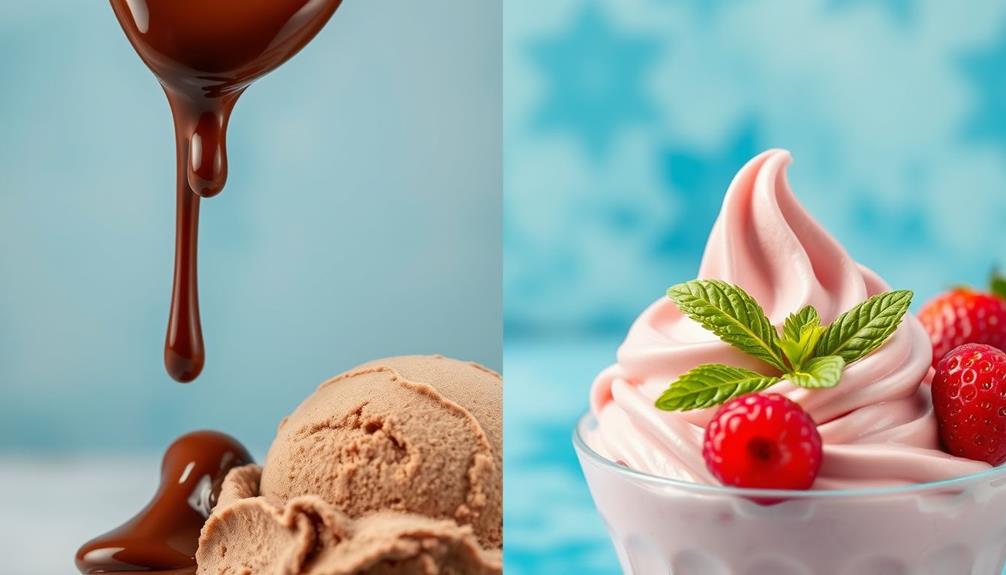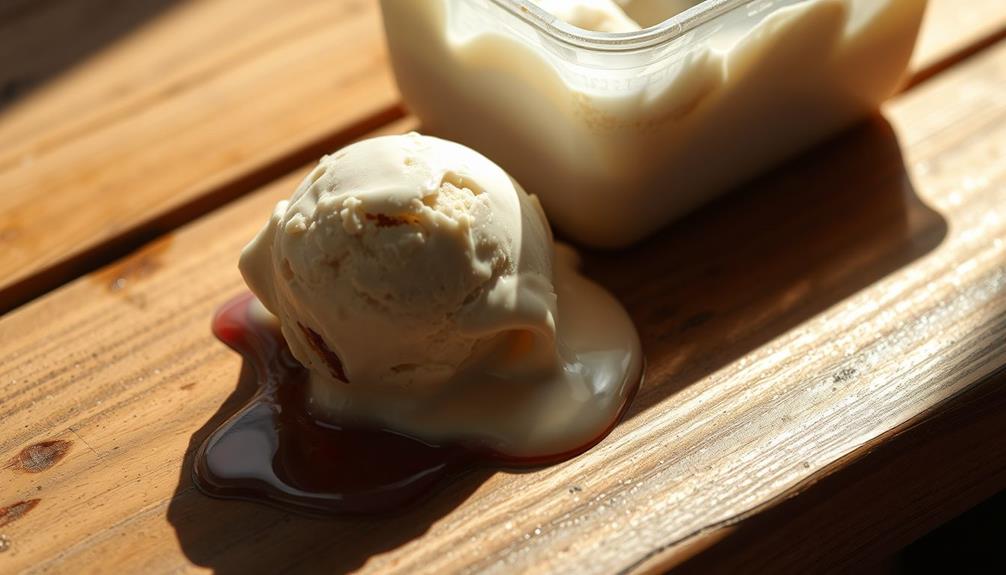Frozen yogurt is often the healthier choice compared to ice cream. It typically contains fewer calories, about 114 calories per half-cup, versus ice cream's 140 calories. You'll also find frozen yogurt has less fat, with around 2.5 grams compared to ice cream's 4.5 grams. Additionally, frozen yogurt may offer probiotics that support digestive health, while ice cream usually lacks these benefits. However, watch out for added sugars in frozen yogurt, which can counteract its healthiness. Exploring more about serving sizes and toppings can help you make better choices in satisfying your sweet tooth.
Key Takeaways
- Frozen yogurt generally has lower calories and fat content compared to ice cream, making it a lighter option.
- Frozen yogurt may contain probiotics, promoting digestive health, while ice cream typically lacks these benefits.
- The sugar content in frozen yogurt can be higher due to added sugars for flavor enhancement.
- Portion control is crucial, as both frozen yogurt and ice cream can lead to significant calorie intake, especially with toppings.
- Homemade frozen yogurt allows for healthier ingredient choices and better control over added sugars compared to commercial products.
Nutritional Comparison
When comparing frozen yogurt and ice cream, it's clear that each has its own nutritional profile worth considering.
You'll notice that frozen yogurt typically has fewer calories, averaging around 114 calories per 1/2 cup, while ice cream clocks in at about 140 calories for the same serving size. If you're watching your fat content, frozen yogurt is often the healthier option, containing around 2.5g of total fat compared to ice cream's 4.5g.
Additionally, frozen yogurt can be a source of probiotics, which may aid in digestive health, similar to how certain teas like rooibos tea benefits may promote gut health.
However, don't overlook the sugar content. While they can be similar, frozen yogurt might have more added sugars to boost flavor, which can sometimes push its sugar levels higher than those found in ice cream.
On the plus side, both treat options provide comparable calcium content, essential for your bone health, with frozen yogurt offering about 143mg per serving and ice cream about 128mg.
Ingredients and Production

Frozen yogurt and ice cream differ markedly in their ingredients and production methods, impacting their taste and health profiles. Understanding these differences can help you make informed choices.
| Aspect | Frozen Yogurt | Ice Cream |
|---|---|---|
| Main Ingredients | Yogurt or cultured milk | Cream |
| Fat Content | 2-6% milk fat | At least 10% milk fat |
| Production Process | Fermentation with yogurt cultures | Churned to incorporate air |
Frozen yogurt typically has a lower fat content due to its yogurt base, while ice cream's cream base results in richer flavors. The fermentation process in frozen yogurt gives it a tangy taste, while the churning method in ice cream creates a lighter, fluffier texture.
Both options can contain added sugars; however, frozen yogurt often has higher levels to balance its tartness. It's essential to check labels for specific nutritional information, as ingredient variations can greatly influence healthiness. Ultimately, knowing what goes into your treat can guide you toward better choices for your diet.
Health Benefits of Each

Choosing between frozen yogurt and ice cream can considerably impact your health, especially if you're mindful of calories and fat intake. Frozen yogurt typically contains fewer calories—about 114 calories per 1/2 cup—compared to ice cream, which has approximately 140 calories per the same serving. This makes frozen yogurt a lighter option for those watching their calorie consumption.
Additionally, many frozen yogurt varieties are made with specialty ingredients that can enhance flavor and health benefits, similar to how specialty beans can elevate coffee experiences.
Furthermore, the lower fat content in frozen yogurt, ranging from 3% to 6% milk fat, is beneficial for individuals aiming to reduce their fat intake, while ice cream can contain 10% to 25% milk fat. Some frozen yogurt brands also include probiotics, which support gut health, a benefit that traditional ice cream lacks.
If you're lactose intolerant, frozen yogurt may aid in digestion due to its lower lactose content, making it a suitable alternative.
Both frozen yogurt and ice cream provide calcium, essential for bone health, but frozen yogurt might offer additional vitamins and minerals depending on its ingredients.
To summarize, while both treats have their perks, frozen yogurt tends to present more health benefits overall.
Flavor and Texture Differences

The flavor and texture of frozen yogurt and ice cream create distinct experiences for your taste buds. Frozen yogurt usually has a tangy flavor profile thanks to the cultured milk it contains, while ice cream tends to be sweeter and richer due to its higher milk fat content, which is at least 10%.
This difference in milk fat affects the creamy texture of each dessert; frozen yogurt typically ranges from 2-6% milk fat, giving it a lighter, smoother mouthfeel. Many vegans enjoy exploring vegan alternatives to traditional dairy desserts, which can include plant-based frozen yogurts.
Ice cream's denser texture results from its fluffiness, which comes from incorporating air during production. Although soft-serve versions of both are smoother, ice cream remains denser overall.
When you indulge in frozen yogurt, you might notice that its flavor balance can lead to higher sugar content, counteracting its natural tanginess. This can influence your preference between the two options.
For a creamier experience, ice cream is often the go-to, while frozen yogurt provides a revitalizing, slightly tangy alternative. Each dessert offers unique characteristics, allowing you to choose based on your cravings and taste preferences.
Portion Control and Serving Sizes

Maintaining portion control is fundamental when enjoying frozen yogurt and ice cream, especially given their calorie and sugar content. A typical serving size of 1/2 cup can contain significant calories and added sugars, making it imperative to monitor what you consume.
Many self-serve frozen yogurt shops encourage larger portions, leading to increased calorie intake if you're not careful. Ice cream, with its richer flavor and creamier texture, can also tempt you to exceed the recommended serving size. The toppings you choose can further amplify the calorie and sugar content of both treats, so limiting them is essential for better portion control.
To help you navigate portion sizes, here's a quick reference table:
| Treat | Typical Serving Size | Calories (Approx.) | Added Sugars (g) |
|---|---|---|---|
| Frozen Yogurt | 1/2 cup | 100-150 | 10-20 |
| Ice Cream | 1/2 cup | 200-300 | 15-30 |
| Toppings (1 oz) | 1 oz | 50-100 | 5-15 |
Practicing mindful eating can help you enjoy smaller portions while being aware of your overall calorie intake.
Probiotics and Digestive Health

When you consider the health benefits of frozen yogurt compared to ice cream, probiotics play a key role in its appeal. These beneficial bacteria can markedly enhance your gut health and improve digestion. Many frozen yogurt brands include probiotics, which are essential for maintaining a balanced gut microbiota. This balance may help reduce gastrointestinal issues like bloating and constipation.
However, not all frozen yogurt contains live cultures, so you should look for products that display the National Yogurt Association's seal to verify you're getting these health benefits. The fermentation process used in making frozen yogurt is designed to boost probiotic content, although keep in mind that freezing may kill off some of these beneficial bacteria.
Regularly consuming probiotics from frozen yogurt can support your immune function and contribute to overall digestive health. Incorporating this tasty treat into your diet can help you enjoy both flavor and health benefits.
Customizing Your Dessert

When you're customizing your dessert, think about how you can enhance both flavor and nutrition.
You can choose from a variety of healthy toppings like fresh fruit or nuts, which not only add taste but also boost the nutritional value.
Flavor Profile Variations
Frozen yogurt offers a unique canvas for dessert customization, allowing you to tailor your treat to match your taste preferences. Its flavor profile is distinct, thanks to the use of cultured milk, which gives it a tangier flavor compared to the sweeter, creamier taste of ice cream. If you prefer lighter options, frozen yogurt's fruit-based or tart flavors are perfect for your palate.
You can easily customize your frozen yogurt by adding toppings like fresh fruit, nuts, or granola. These additions not only enhance the flavor but also boost nutritional value.
In contrast, ice cream typically focuses on richness and indulgence, with flavors like chocolate fudge or cookie dough that highlight its higher fat content.
However, be mindful of the sugar content in frozen yogurt. Sometimes, the tanginess is balanced with higher sugar levels, which may surprise you.
Depending on the frozen yogurt's production method, the texture can vary, offering options from smooth, soft-serve to firmer varieties. Each choice affects your overall dessert experience, making it essential to reflect on how you want to customize your treat.
Healthy Topping Options
Customizing your frozen yogurt with healthy toppings can elevate your dessert while keeping it nutritious. Start by adding fresh fruits like berries, bananas, or mangoes. These fruits provide natural sweetness and essential vitamins without excessive sugar.
Next, consider incorporating nuts and seeds, such as pistachios or chia seeds. They offer healthy fats, protein, and fiber, enhancing the nutritional profile of your treat.
For a touch of indulgence, opt for dark chocolate chips instead of milk chocolate. This choice reduces sugar intake while adding antioxidants and a rich flavor. You can also drizzle Greek yogurt or nut butter over the top. These toppings introduce extra protein and probiotics, contributing to gut health and keeping you feeling full longer.
Be mindful to avoid sugary syrups and excessive candies, as they can greatly increase calories and sugar content, undermining the health benefits of your frozen yogurt.
Homemade Alternatives

Making your own frozen yogurt at home can be a healthier and more enjoyable option than buying it from the store. By using Greek yogurt, you boost protein content and reduce calories, making your homemade frozen yogurt a nutritious dessert.
Blending your favorite fruits with yogurt and freezing the mixture allows you to create a delicious treat with lower added sugars, tailored to your taste preferences. You can control your sugar intake by using natural sweeteners like honey or maple syrup, unlike many commercial options that are packed with high added sugars.
Plus, making frozen yogurt at home gives you the flexibility to adjust the ingredients for any dietary restrictions. You can easily incorporate healthy toppings like nuts, seeds, or fresh fruit to enhance both flavor and nutritional benefits.
Not only is this method a cost-effective way to enjoy frozen yogurt, but it also empowers you to create a tailored recipe that fits your lifestyle. In no time, you can whip up a delightful dessert that satisfies your cravings while keeping your health goals in check.
Consumer Tips for Choices

When you're choosing between frozen yogurt and ice cream, always check the nutritional labels to see what's really in each option.
Keep an eye on portion sizes, especially at self-serve stations, to avoid going overboard on calories and sugars.
Nutritional Label Insights
Guiding through the nutritional labels on frozen yogurt and ice cream can help you make more informed choices. When you're checking the calories, you'll find that frozen yogurt typically averages around 114 calories per half-cup serving, while ice cream usually has about 140 calories. This lower calorie count can be appealing if you're watching your intake.
Next, pay attention to the fat content. Frozen yogurt contains about 3%-6% milk fat, whereas ice cream must have at least 10% milk fat by law.
However, be cautious—frozen yogurt can sometimes have higher added sugar levels than ice cream. Always check the nutritional label for total sugar content to avoid surprises.
Both options offer similar calcium levels, with frozen yogurt providing approximately 143mg and ice cream around 128mg per 100g, which is beneficial for bone health.
If you're interested in probiotic benefits, look for labels indicating "live and active cultures" on frozen yogurt. Not all brands include these beneficial bacteria, so this detail can make a significant difference in your choice.
Portion Control Strategies
Controlling your portions of frozen yogurt or ice cream can make a big difference in your overall calorie intake. Aim for a portion size of half a cup to manage those calories, as both treats can be calorie-dense.
When you're at a self-serve station, be mindful of your toppings; they can greatly increase both sugar and calorie content. Opt for fresh fruit or nuts instead of sugary options like candy or syrups for a healthier choice.
Reading nutritional labels is essential. Check for added sugars and select options with lower sugar content to make better decisions.
If you're craving something sweet, consider sharing a dessert with a friend or family member. This way, you can reduce portion sizes while still enjoying the treat together.
Lastly, practice mindful eating. Savor each bite and pay attention to your hunger cues. This approach can help prevent overeating during dessert time, allowing you to enjoy your frozen yogurt or ice cream while keeping your calorie intake in check.
Balancing Treats in Your Diet

Treats can definitely have a place in your diet, and finding the right balance is important for maintaining a healthy lifestyle. Both frozen yogurt and ice cream can be enjoyed in moderation, but it's imperative to pay attention to calories and fat content. Frozen yogurt is often a healthier choice, containing fewer calories and less fat than ice cream.
When indulging in these treats, portion control is essential. Toppings like candies and syrups can quickly escalate the sugar and calorie count, so choose wisely. Enjoying frozen yogurt or ice cream occasionally promotes a healthier relationship with food. Instead of daily habits, consider them as treats to savor.
Here's a quick comparison to help you make informed choices:
| Frozen Yogurt | Ice Cream | |
|---|---|---|
| Calories | Fewer | More |
| Fat | Less | Higher |
| Toppings | Choose wisely | Be cautious |
| Moderation | Important | Key |
| Nutrition Labels | Check | Significant |
Frequently Asked Questions
Is Frozen Yogurt Better Than Ice Cream for You?
When considering if frozen yogurt's better for you, it often has lower fat and calories. However, watch for added sugars. Always check labels to make informed choices that align with your health goals.
Is Frozen Yogurt Healthy for Weight Loss?
Frozen yogurt can be healthy for weight loss if you watch your portions and choose options with lower added sugars. Keep an eye on toppings, and you'll make a smarter choice for your goals.
Is There Such Thing as Healthy Frozen Yogurt?
Did you know that some frozen yogurts contain probiotics, which might support your digestive health? While not all frozen yogurts are healthy, checking nutrition labels can help you make better choices about sugar and calories.
What Is the Healthiest Ice Cream?
When you're choosing the healthiest ice cream, look for options with lower sugar, natural ingredients, and added nutrients. Check labels for calorie counts and portion sizes to enjoy a treat without compromising your health goals.
Conclusion
In the sweet dance of dessert choices, frozen yogurt often twirls gracefully ahead of ice cream, symbolizing a lighter indulgence. While it may seem like a guilt-free option, remember that both treats can fit into your life's tapestry. Embrace the joy of customizing your dessert, savoring each bite, and balancing these delights with mindful choices. Ultimately, it's not just about health, but the happiness these treats bring to your moments. Enjoy them as part of your delicious journey!










